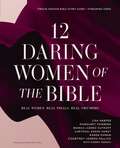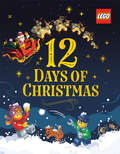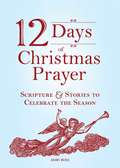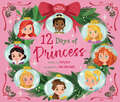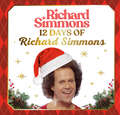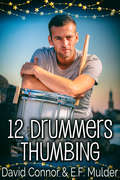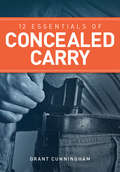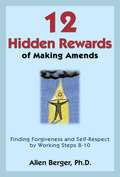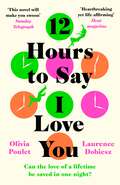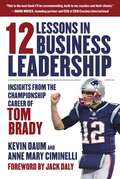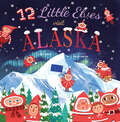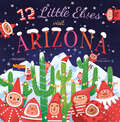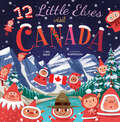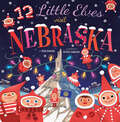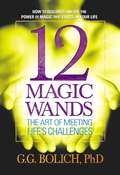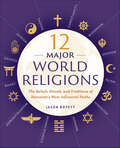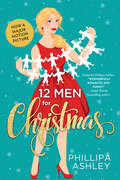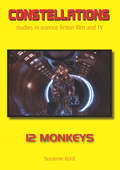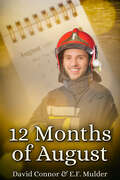- Table View
- List View
12 Daring Women of the Bible Study Guide plus Streaming Video: Real Women, Real Trials, Real Triumphs
by Lisa Harper Margaret Feinberg Karen Ehman Bianca Juarez Olthoff Chrystal Evans Hurst Courtney Joseph FallickIn this twelve-session video Bible study, some of today's best-loved Christian authors and speakers look at the spiritual lessons learned from twelve daring women in the Bible and what they mean for you today.As you look at each of these women&’s lives, you will discover how to:Apply biblical lessons to your own modern-day struggles.Live through your failures as well as your successes.Draw near to God in a world filled with trials.Find lasting contentment in every situation.Overcome rejection and insecurity . . . and much more.You&’ll study the lives of . . .Shulamite Woman: We Had God at Hello (Lisa Harper) Deborah: Fight Like a Girl (Bianca Juarez Olthoff)Proverbs 31 Woman: How Not to Do It All (Karen Ehman)Ruth: Staying Focused in a World of Distractions (Chrystal Evans Hurst)Puah and Shiphrah: How to Fight Your Fears (Margaret Feinberg)Esther: Letting God Be in Control (Courtney Joseph)Priscilla: Living a Life of Blessed Ordinary (Karen Ehman)Mary and Martha: Finding Life in Death (Bianca Juarez Olthoff)Bent Woman: We've Got God's Complete Attention (Lisa Harper)Woman with the Issue of Blood: When Persistence Pays Off (Chrystal Evans Hurst)Elizabeth: How to Win the Waiting Game (Margaret Feinberg)Anna: How to Live a Life Devoted to God (Courtney Joseph Fallick)This study guide includes:Individual access to twelve streaming video sessionsBackground information on each womanVideo notes and a comprehensive structure for small group discussion timePersonal study and reflection materials for in-between sessionsGroup leader helps Previously published as Twelve More Women of the Bible.
12 Day Body Shaping Miracle: Change Your Shape, Transform Problem Areas, and Beat Fat for Good
by Michael ThurmondWonder why all those hours spent on the treadmill or lifting weights aren't getting you the results you want? According to Thurmond, if you're not working out in a way that's just right for your individual body type, you're wasting time and energy. In 12-Day Body Shaping Miracle, Michael Thurmond presents his breakthrough exercise program for getting your body into a better proportional balance. Using Thurmond's exclusive "blueprinting system", you'll identify your unique metabolism and body type. You'll then discover a personalized exercise plan to quickly target your specific problem areas and transform your body shape in just 12 days. For example, if you are bottom heavy, you learn how to trim your thighs and hips while building up your shoulders and back, giving your body that trimmer, more hourglass-like shape. Thurmond's unique program focuses on sculpting muscles through select, easy-to-do weight training techniques with cardiovascular activity. And, no matter what your starting weight, level of fitness or shape is, Thurmond guarantees rapid results.
12 Days of Christmas (LEGO)
by Margaret WangJoin in a super-silly Christmas celebration based on an all-new LEGO® holiday song!The holiday season can get a little kooky—especially when LEGO® friends come to visit. Get ready for Christmas with an ever-growing cast of merry guests, including festive robots and pirates. Inspired by an all-new video that puts a silly LEGO® spin on &“The Twelve Days of Christmas,&” this full-color hardcover picture book is sure to thrill boys and girls ages 3 to 7—and collectors of all ages. LEGO, the LEGO logo, the Brick and Knob configurations, and the Minifigure are trademarks of the LEGO Group. ©2021 The LEGO Group.Manufactured by AMEET Sp. z o.o. under license from the LEGO Group.
12 Days of Christmas Prayer: Scripture and Stories to Celebrate the Season
by Adams MediaRing in this joyous season with a lovely selection of uplifting holiday stories and prayers. 12 Days of Christmas Prayer offers reflections on how the Christmas spirit brightens our lives during this merry time. Whether it is the unique style of gift exchange that brings a family closer together or the faith of a child that restores the holiday spirit in all, you will feel the warmth and cheer of these holy days leading up to your holiday celebrations. Enjoy and Merry Christmas!
12 Days of Princess
by Holly P RiceAn adorable Disney Princess holiday picture book inspired by the classic carol, "The Twelve Days of Christmas." Inspired by the famous song “The Twelve Days of Christmas,” a new holiday tradition is here: the twelve days of princess! Countdown to Christmas with Tiana, Rapunzel, Merida, Cinderella, Belle, Aurora, Snow White, and Ariel. Each day brings a new magical gift, like two glass slippers or seven singing dwarfs, from one of your favorite Disney Princesses to help get you into the holiday spirit. Sing-along to the melody of The Twelve Days of Christmas The perfect bedtime story read-aloud for the holiday seasonCountdown to Christmas with your favorite Disney charactersComplete your story book collection with these fan-favorite, best sellers: Disney Christmas Storybook CollectionDisney Halloween Storybook CollectionDisney Countdown to Christmas5 Minute Girl Power Stories5 Minute Princess StoriesDisney Princess Storybook Collection
12 Days of Richard Simmons
by Penguin Young Readers LicensesCelebrate the holidays with Richard Simmons!Celebrate the holidays with fitness legend Richard Simmons! This gift book is perfect as a stocking stuffer for fans who like to disco sweat to the Christmas oldies.
12 Dogs of Christmas
by Emma KragenNow available as a novel based on the screenplay written by Kieth Merrill, this story is destined to become a classic for young readers during the holiday season. The film centers around 12-year-old Emma O'Connor as she is sent to live with her "aunt" in the small town of Doverville. Emma soon finds herself in the middle of a "dog-fight" with the mayor and town dogcatcher. In order to strike down their "no-dogs" law, Emma must bring together a group of schoolmates, grown-ups, and adorable dogs of all shapes and sizes in a spectacular holiday pageant. The 12 Dogs of Christmas is a fun, heartwarming story, featuring a diverse canine cast and is perfect for all those who love dogs, kids, and Christmas. The 12 Dogs of Christmas was first introduced as a picture book and board book with companion CD written by then 8-year-old, Emma Kragen. Now with over 500,000 books sold, the story has been expanded into a feature-length film. "Leiva recounts the story in a very crisp, snappy style of prose which is full of humor and warmth...it's on it's way to becoming a Christmas standard."Stuart Nulman "Bookbanter" on CJAD, Montreal
12 Drummers Drumming: A Novel of Suspense
by Diana DeverellAn international spy thriller written by a former Foreign Service officer.
12 Drummers Thumbing
by David Connor E. F. MulderBecause of his severe stutter, Atticus never fulfills his childhood wish to make a joyful noise onstage at Christmastime. Now going by AC, the same problem isolates him with only his cat Spud for company as he forgoes the holiday season and personal, meaningful relationships altogether.On their way to pass the yuletide in Mexico, AC and Spud encounter a stranded band who call themselves The 12 Drummers Drumming. Though AC tries to resist the urge to help, he’s somehow convinced to drive them back up north in his van to ensure they make their Christmas Eve gig.AC immediately rates each guy, figuring on a one in twelve chance to at least score a holiday hookup. As he spends time with each, he sees them in less superficial terms. Sparks ignite, and by the time Christmas Eve arrives, AC has a whole new reason to believe in Christmas magic and romance.
12 Essentials of Concealed Carry
by Grant CunninghamBasic tips to get started in safe and responsible concealed carry.You'll Love This If:You're interested in concealed carry trainingYou're new to defensive shootingYou believe in your right of self-defenseIn 12 Essentials of Concealed Carry, certified Combat Focus Shooting instructor Grant Cunningham breaks concealed carry down into its most important elements. Learn about critical topics like concealed carry laws, choosing the right gun, methods of concealment, interacting with law enforcement and much more. Cunningham draws upon his years of experience to provide a solid foundation of knowledge on safe and responsible concealed carry. This book is a must read for anyone interested in exercising their right of personal defense.You'll Learn About:Concealed carry safetyHow to interact with law enforcementChoosing a concealed carry gunChapters Include:MindsetWhat Your Concealed Carry License AllowsAmmunition for Self DefenseConcealmentPlus, many detailed photos demonstrating proper methods
12 Great Classics of Science Fiction
by Groff ConklinThis book presents 12 masterful tales of science fiction that are perceptive, witty, exciting and skillfully written and every story is a fascinating voyage of the creative imagination. The authors and titles are: George Sumner Albee, THE TOP; Poul Anderson, MY OBJECT ALL SUBLIME; J. F. Bone, ON THE FOURTH PLANET; Fredric Brown, EARTHMEN BEARING GIFTS; Algis Budrys, DUE PROCESS; A. Bertram Chandler, THE CAGE; Zenna Henderson, THINGS; J. T. Mclntosh, IMMORTALITY ... FOR SOME; Robert Scheckley, HUMAN MAN'S BURDEN; Cordwainer Smith, BALLAD OF LOST C'MELL; William W. Stuart, STAR-CROSSED LOVER; and, Robert F. Young, THIRTY DAYS HAD SEPTEMBER.
12 Hidden Rewards of Making Amends: Finding Forgiveness and Self-Respect by Working Steps 8-10
by Allen BergerPopular recovery author Allen Berger, PhD, guides us in working three of the most challenging of the Twelve Steps to reap the abundant rewards of making amends.Letting go of resentment and forgiving ourselves for our past wrongs are critical to recovery from alcohol and other drugs. Yet, Steps Eight, Nine, and Ten, which focus on making amends, can be some of the most challenging to work, because we must face ourselves and those who we have hurt or damaged.In 12 Hidden Rewards of Making Amends, Allen Berger, PhD, uses the same supportive, down-to-earth style as in his popular book 12 Stupid Things That Mess Up Recovery. His creative tools and tips will help us let go of anger, heal strained relationships, and make financial and emotional restitution. Through this transformative process we can:recover and maintain integrityresolve or complete unfinished businessrestore trust, self-esteem, and self-confidencedeepen our spirituality and peace of mindreinforce a strong commitment to recoveryBy being accountable for our words and actions and moving forward with a compassionate and constructive approach to the world, we decrease our chance of relapse and learn to maintain a healthy, balanced life.
12 Hours To Say I Love You: Read the most romantic and heartwrenching book of 2022
by Olivia Poulet Laurence DobieszTheirs was the love of a lifetime.Now they have one night to save it.'A wonderfully romantic book' KEIRA KNIGHTLEY'Not just a beautifully tender love story but also a wonderful journey of exaltation, desperation and heartbreak - life-affirming' TOM ALLEN'Hilarious and heartbreaking, a rollercoaster you won't want to get off' SARA PASCOE'Captivating. I loved it' REBECCA HALL'A glorious love story that you won't be able to put down. Relatable. Funny. Heartbreaking' DEBORAH FRANCES-WHITE'Beautiful... This drowns in love' SIOBHÁN MCSWEENEY_________________________Gripping, moving and beautifully observed, this is a love story told from both sides, with warmth, tenderness and heart.Whir, beep, click, breath. Whir, beep, click, breath.Pippa Gallagher is rushed in to hospital following a traffic accident.As Pippa lies unconscious, she is aware of fragments. The day she met Steve Gallagher, her best friend and the man who would become the love of her life. The heartbreak she felt tonight as she got into her car, her eyes blurry from tears.Meanwhile Steve sits at her bedside, his eyes fixed on her pale, still face. He has no idea where his wife was going when she crashed. No clue as to why she became distracted behind the wheel. All he knows is that she is his world. And that he wasn't there when she needed him most. For the next twelve hours, Steve tells Pippa all the reasons he loves her.But is it too late? Can Pippa find her way back to him?_________________________Just some of the early real reader reviews for 12 HOURS TO SAY I LOVE YOU:'An absolute joy to read. A book for anyone who is in love, has loved or been loved *****''Oh my gosh, I can't even with this book. It was stunningly beautiful and emotive. I laughed, I cried and I felt totally heartbroken. A beautiful story that both made me hopeful and emotionally destroyed at the same time. I loved it. *****''A beautiful, moving love story - poignant and so very real. Explores the beautiful, messy chaos that is falling in and staying in love. The connection between them was so real that my heart broke for them with every page, and it felt as though we've lived through their relationship alongside them. A truly heartbreakingly stunning story about love and loss, fans of If I Stay will definitely love this story ****''This is such a beautiful love story. Although it is quite heartbreaking... there are quite a lot of funny moments. Such a great cast of characters. Great storyline and quite emotional. Thoroughly entertaining *****'This was a tender, emotional read. It was romantic as you would expect, yet not schmaltzy or unrealistic. I found it to be a beautiful and thought-provoking book. I really enjoyed it ****'A beautifully written romance that had me rooting for the characters throughout. The perfect weekend read'(P)2022 Headline Publishing Group Limited
12 Hours To Say I Love You: Read this book and your heart won't be the same - the Must-Read Love Story of 2022
by Olivia Poulet Laurence DobieszTheirs was the love of a lifetime.Now they have one night to save it...GRIPPING, MOVING AND BEAUTIFULLY OBSERVED, THIS NOVEL CELEBRATES THE MESSINESS AND THE MIRACLE OF THAT THING WE CALL LOVE. 'Wonderfully romantic' KEIRA KNIGHTLEY'Beautifully tender and life-affirming' TOM ALLEN'Relatable. Funny. Heartbreaking. Glorious' DEBORAH FRANCES-WHITE_________________________Whir, beep, click, breath. Whir, beep, click, breath. Pippa Gallagher is rushed in to hospital following a traffic accident.As Pippa lies unconscious, fragments of the past flash through her mind. The day she met Steve Gallagher, the man who would become the love of her life. The heartbreak she felt tonight as she got into her car, her eyes blurry from tears. Meanwhile Steve sits at her bedside, his eyes fixed on her pale, still face. He has no idea where his wife was going when she crashed. No clue as to why she became distracted behind the wheel. All he knows is that she is his world. And that he wasn't there when she needed him most. For the next twelve hours, Steve tells Pippa all the reasons he loves her. But is it too late? Can Pippa find her way back to him?HAVE YOU READ THE LOVE STORY EVERYONE IS TALKING ABOUT?'Witty, tender and compulsively readable!' DIANA GABALDON, bestselling author of OUTLANDER'Hilarious and heartbreaking' SARA PASCOE'Captivating. I loved it' REBECCA HALL'This drowns in love. 'Beautiful' SIOBHÁN MCSWEENEY_________________________Early readers ADORE this beautiful novel:'Oh my gosh, I can't even with this book. It was stunningly beautiful and emotive. I laughed, I cried and I felt totally heartbroken. A beautiful story that both made me hopeful and emotionally destroyed at the same time. I loved it. *****''An absolute joy to read. A book for anyone who is in love, has loved or been loved *****''Oh my gosh, this book nearly broke me. It was so romantic and funny and real and relatable. I loved every page. That ending is amazing. Highly recommend *****''A beautiful, moving love story, poignant and so very real. Explores the beautiful, messy chaos that is falling in and staying in love. The connection between them was so real that my heart broke for them with every page, and it felt as though we've lived through their relationship alongside them. A truly heartbreakingly stunning story about love and loss, fans of If I Stay will definitely love this story ****' 'This is such a beautiful love story. Although it is quite heartbreaking... there are quite a lot of funny moments. Such a great cast of characters. Great storyline and quite emotional. Thoroughly entertaining *****'This was a tender, emotional read. It was romantic as you would expect, yet not schmaltzy or unrealistic. I found it to be a beautiful and thought-provoking book. I really enjoyed it ****'A beautifully written romance that had me rooting for the characters throughout. The perfect weekend read'
12 Hours To Say I Love You: Read this book and your heart won't be the same - the Must-Read Love Story of 2022
by Olivia Poulet Laurence DobieszTheirs was the love of a lifetime.Now they have one night to save it...GRIPPING, MOVING AND BEAUTIFULLY OBSERVED, THIS NOVEL CELEBRATES THE MESSINESS AND THE MIRACLE OF THAT THING WE CALL LOVE. 'Wonderfully romantic' KEIRA KNIGHTLEY'Beautifully tender and life-affirming' TOM ALLEN'Relatable. Funny. Heartbreaking. Glorious' DEBORAH FRANCES-WHITE_________________________Whir, beep, click, breath. Whir, beep, click, breath. Pippa Gallagher is rushed in to hospital following a traffic accident.As Pippa lies unconscious, fragments of the past flash through her mind. The day she met Steve Gallagher, the man who would become the love of her life. The heartbreak she felt tonight as she got into her car, her eyes blurry from tears. Meanwhile Steve sits at her bedside, his eyes fixed on her pale, still face. He has no idea where his wife was going when she crashed. No clue as to why she became distracted behind the wheel. All he knows is that she is his world. And that he wasn't there when she needed him most. For the next twelve hours, Steve tells Pippa all the reasons he loves her. But is it too late? Can Pippa find her way back to him?HAVE YOU READ THE LOVE STORY EVERYONE IS TALKING ABOUT?'Witty, tender and compulsively readable!' DIANA GABALDON, bestselling author of OUTLANDER'Hilarious and heartbreaking' SARA PASCOE'Captivating. I loved it' REBECCA HALL'This drowns in love. 'Beautiful' SIOBHÁN MCSWEENEY_________________________Early readers ADORE this beautiful novel:'Oh my gosh, I can't even with this book. It was stunningly beautiful and emotive. I laughed, I cried and I felt totally heartbroken. A beautiful story that both made me hopeful and emotionally destroyed at the same time. I loved it. *****''An absolute joy to read. A book for anyone who is in love, has loved or been loved *****''Oh my gosh, this book nearly broke me. It was so romantic and funny and real and relatable. I loved every page. That ending is amazing. Highly recommend *****''A beautiful, moving love story, poignant and so very real. Explores the beautiful, messy chaos that is falling in and staying in love. The connection between them was so real that my heart broke for them with every page, and it felt as though we've lived through their relationship alongside them. A truly heartbreakingly stunning story about love and loss, fans of If I Stay will definitely love this story ****' 'This is such a beautiful love story. Although it is quite heartbreaking... there are quite a lot of funny moments. Such a great cast of characters. Great storyline and quite emotional. Thoroughly entertaining *****'This was a tender, emotional read. It was romantic as you would expect, yet not schmaltzy or unrealistic. I found it to be a beautiful and thought-provoking book. I really enjoyed it ****'A beautifully written romance that had me rooting for the characters throughout. The perfect weekend read'
12 Lessons in Business Leadership: Insights From the Championship Career of Tom Brady
by Kevin Daum Anne Mary CiminelliExpert analysis of the leadership style of New England Patriots quarterback Tom Brady! The merits of business leaders are under scrutiny more and more these days, whether it&’s Travis Kalanick, Elon Musk, Mark Zuckerberg, or many others. But there&’s one place where true leadership is always revealed: on the field. And no matter what you think of the New England Patriots or the Tampa Bay Buccaneers, you can&’t argue with the success of Tom Brady, the winningest quarterback of all time. Both revered and hated by football fans, Brady is loved and respected by those who work with him, and his leadership abilities cannot be denied by even his harshest critics. The skills he uses to make his team successful year after year on the field can be executed in the workplace, whether you&’re a team member, team leader, or CEO. In 12 Lessons in Business Leadership: Insights From the Championship Career of Tom Brady, authors Kevin Daum and Anne Mary Ciminelli team up to analyze the strong leadership abilities of the six-time Super Bowl Champion, and translate them into accessible, practical lessons for any stage of your career. In this easy-to-read, entertaining book, the authors help you acquire and practice all the skills you need to have a championship season every year of your career. Practical and instructive, this book makes the perfect gift for anyone looking to rise in their particular vocation or looking to emulate one of the most respected leaders of today! Each chapter focuses on one of twelve leadership lessons gleaned from Brady&’s career and why it matters in your life and career. In the Executing the Play section of each chapter, the authors outline best practices on how leaders can apply that lesson in their workplace, as well as share exercises leaders can complete to develop and strengthen the skill and implement the lesson.
12 Little Elves Visit Alaska (12 Little Elves Ser. #9)
by Trish Madson12 little elves visit Alaska and enjoy popular stops along the way!
12 Little Elves Visit Arizona
by Trish Madson12 little elves visit Arizona and visit popular stops along the way!
12 Little Elves Visit Canada (12 Little Elves Ser. #5)
by Trish MadsonFrom Delta Falls to the Quebec Winter Carnival to the McKenzie River to Banff and more, these 12 little Christmas elves take in hockey games, ride Canadian geese, walk The Edge, and fall in love with maple syrup.
12 Little Elves Visit Nebraska (12 Little Elves Ser. #6)
by Trish Madson Valeria DanilovaTwelve charming Christmas elves travel throughout Nebraska to see who is still awake before Santa comes. Along the way, they visit state landmarks and curiosities, all bedecked in holly and holiday fun.
12 Magic Wands: The Art of Meeting Life's Challenges
by G. G. BolichThis insightful guide is for recognizing the magic in your life, and using it to improve your physical, mental, and spiritual self. After explaining what magic is, the book offers twelve magic &“wands.&” Each wand provides practical tools and exercises to gain control over a specific area in your life, such as friendship and love. Included are inspiring true stories of people who have used the magic in their lives to both help themselves and point the way to others.
12 Major World Religions: The Beliefs, Rituals, and Traditions of Humanity's Most Influential Faiths
by Jason BoyettFor billions of people, having a religious belief system provides purpose in life. For some, religion serves as a guide for moral behavior. Today's world is one in which our understanding of world religions is both understatedly important, as well as increasingly complex.After many years exploring the foundations of various world religions, Jason Boyett has written this comprehensive, easy-to-understand exploration of the twelve major world religions through a meticulous, yet unbiased lens. 12 Major World Religions offers an impartial look at where each of these belief systems intersects, how they differ, and why some have been—or are currently—misunderstood.
12 Men for Christmas
by Phillipa AshleyThe novel that inspired a Lifetime Original Christmas movie! When Emma loses nearly everything right before the holidays, she needs a change…and she's about to get a whole lot more than she bargained for…Emma Tremayne planned to be wrapped up in Christmas cheer with her boyfriend, but when she finds him in the arms of her boss, she loses her man and her job instead. Determined to find some peace and quiet until she can figure out her next move, she heads to the Lake District. But when she lands a new job with the tourist board and ends up responsible for a fundraiser involving handsome naked men and a calendar photoshoot, quiet is the last thing she'll be getting. One of the handsome men playing Santa might be the best man to brighten her holiday, and she's more than willing to try them out one at a time…Set in England's Lakeland district, home to the country's highest mountains and deepest lake, and as unpredictable as the region's ever-changing weather, this funny, fast-paced Christmas romance is full of twists and turns that are as dramatic as its setting.(Originally published as Dating Mr. December)
12 Monkeys (Constellations)
by Susanne KordTerry Gilliam’s 12 Monkeys (1995) was a commercial and critical success, but it is Gilliam’s least understood film, even on the basic plot level. Aside from recognizable debts to specific films such as La Jetée (1962) and Dr. Strangelove (1964), 12 Monkeys plays with a number of genres: apocalypse and postapocalypse movies, sci-fi, nuclear noir, and what is becoming known as “geek dystopia.” This volume in the Constellations series examines Gilliam’s film—and briefly the TV series based on it—in the context of post-apocalypse movies and with an eye to the film’s major themes, including mental illness, conspiracy theories, the impossibility of human closeness, and the nature of reality. It is the first to read 12 Monkeys’s portrayal of time travel in light of Einstein’s ideas about time and to ask what answers these ideas suggest to the film’s most basic philosophical predicament: the problem of free will versus determinism.
12 Months of August
by David Connor E. F. MulderAt work, August’s new job as a firefighter brings opportunity to model for a beefcake calendar. At home, a no strings hookup becomes a regular thing. The new man in August’s life calls himself Memo. He eventually explains it’s a nickname for Guillermo, and with that also reveals something a little bit shocking.When August is excluded from the calendar for reasons objectionable to some, word spreads throughout the town, and the community becomes divided. Memo says he can’t take sides, which bothers August. August’s work partner Tasha has his back. Why can’t the man in his life? Things are bumpy for the pair and the town, but when something more sinister happens, it not only puts the calendar debate in perspective, it also puts August and his fellow firefighters’ lives in danger.Can August and Memo work out their differences, or will what they have literally go up in flames?
